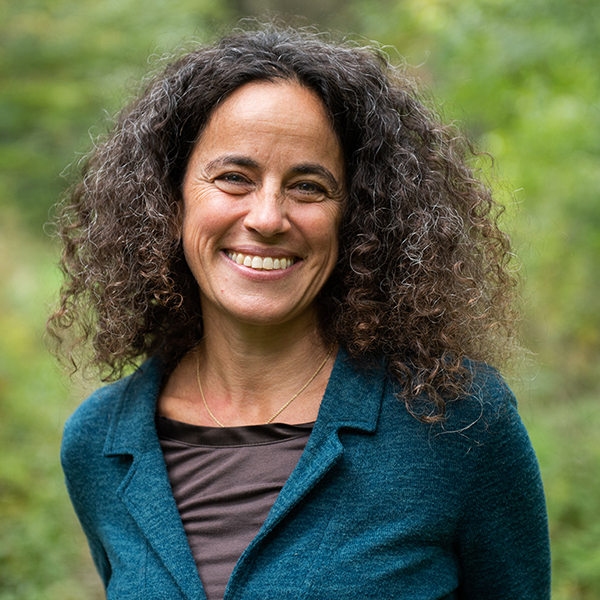With each passing day, there seems to be fresh news about how artificial intelligence is poised to change our lives. Humans aren’t the only ones being impacted. A new research chair will be exploring the ways in which AI can be used to help dairy cattle have longer, healthier lives.
The new Research and Innovation Chair in Animal Welfare and Artificial Intelligence (WELL-E) was recently launched with a $5 million dollar grant from industry and government sources, including the Natural Sciences and Engineering Research Council of Canada (NSERC).
Elsa Vasseur, an associate professor in the Department of Animal Science at Macdonald Campus, and Abdoulaye Baniré Diallo, PhD’09, a computer science professor at the Université du Québec à Montréal, are the WELL-E co-chairs, and their work will be supported by a team of postdoctoral fellows, graduate students, and undergraduate trainees.
The dairy industry plays an important role in the country’s economy, employing more than 43,000 Canadians. Vasseur and the WELL-E team will be using AI, monitoring equipment and databases to develop methods for keeping careful track of cattle, looking for early warning signs of potential problems so that they can be addressed before they become serious. The project will begin with two pilot research farms before expanding to a network of more than 100 farms in Quebec and Ontario.
The McGill News contributor Sylvain Comeau spoke to Professor Vasseur about WELL-E and her research.
How does your work contribute to industry norms?
We started this work in 2015, so we have quickly gone from research to implementation and aim to have a direct impact on the quality of life of the animals. Most of our research is being incorporated into the new Code of Practices for dairy farming in Canada, which was released on March 30.
To date, our research has led to the redesigns of barns, in order to increase the opportunity of movement for the animals, and to improve their outdoor access, so that they get more exercise.
How will you use artificial intelligence in the new research chair?
We collect a lot of data, with the help of video cameras and sensors, to monitor animal behaviours and see how they use their environment. Our objective is to automate these indicators of animal behaviors and welfare, and scale them for commercial farms, using machine learning and algorithms. We want to develop early indicators for predictions of changes in animal health and welfare, and, therefore, enable early intervention.
What do you mean by early intervention?
We will look for early warning signs, before an animal’s health deteriorates. If there is a very early change in the animal’s gait, for example, this is one of the many signs we will get to see with artificial intelligence. Then, we can treat the animal long before it becomes lame.
What is an animal’s gait?
We rely on sensors to track how many steps an animal takes every day and use specialized software for analyzing the attributes of their gait, such as the length of their tread, or joint flexion. A change in these can indicate that the animal is developing health issues. As in human medicine, we want to diagnose problems early.
Manually, it would take a long time to make sense of such a large volume of data. Our objective, in teaming up with computer scientists, is to automate this data processing and measurement.
So, we are getting closer to treating animals the way we treat people – trying to avoid problems, discomfort, and pain?
Yes, and we use the same kind of technology that has been used in kinesiology, to understand movement in athletes, for instance. For our research, we have redesigned it to monitor animals.
Does your research provide incentives for farms to treat animals better? Does a happier cow mean a more productive one?
These animals are already highly productive. Our goal is to give them a longer life span, and we can do that by improving their quality of life.
How can that be accomplished?
We are trying to understand how the housing environment impacts an animal’s psychological needs. For example, can we improve the social enrichment of the animals?
What do you mean by social enrichment?
This is a growing area of research. Enrichment is a broad term that encompasses any addition to the animal’s environment that adds complexity. In the case of social enrichment, this refers to alterations to the environment that enable social interactions.
We know that cows are very social animals; that’s why they are typically in herds. We want to improve the social aspects of the animals’ living environment. For example, is there a benefit to grouping them with preferred social partners, and what does that mean for their emotional wellbeing?
So, research does show that animals make friends?
Yes, and we plan on using that as a parameter to design their environment. We are looking at the benefits of placing them with their friends, in addition to other factors, such as age groups. Would they benefit from learning from older animals?
What other changes would you like to see, in terms of how farm animals are treated?
That ultimately depends on what society chooses.
As scientists, we develop knowledge, to better understand the physical and psychological experience of animals in their environment. Eventually, some of this will lead to improved practices.
But the direction we want to take, as far as the treatment of animals and what we believe is acceptable, is a societal choice. To what extent are we willing to support change on farms? How much is the consumer willing to pay, how much is the government willing to pay?
As a society [we need to decide] what is our responsibility to animals, and how should we care for them.


